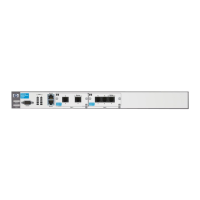8-9
Configuring Demand Routing for Primary ISDN Modules
Overview of ISDN Connections
R Interface. The R interface is used to connect a TE2 device to the TA.
Because there are no standards for the R interface, the vendor providing the
TA determines how the TA connects to and interacts with the TE2.
Line Coding for ISDN BRI Connections
To provide higher transmission rates on ordinary telephone wire, ISDN BRI
uses a compressed encoding scheme called 2B1Q. Essentially, this transmis-
sion scheme uses four signal levels, each of which encode one quaternary
symbol. A single quaternary symbol, in turn, represents two bits.
The two encoded bits can have up to four different values, each expressed as
a different voltage level on the transmission line, as shown in Table 8-1.
Table 8-1. 2B1Q Compressed Line Encoding Scheme
Note that zero voltage is not a valid signal level.
In addition to compressing data, 2B1Q operates in full duplex mode, allowing
data to be transmitted simultaneously in both directions on the local loop.
ISDN Data Link Layer Protocols
As mentioned earlier, the signaling information used to create and maintain
ISDN connections is transmitted over the D channel. The ITU Telecommuni-
cations Standardization Sector (ITU-T) has defined two protocols for ISDN
signaling. These protocols operate at Layer 2 (Data Link Layer) and Layer 3
(Network Layer) of the OSI model:
■ Q.921, which is also called Link Access Procedure for D channel (LAPD)
■ Q.931
Binary Quartenary Symbol Line Voltage
00 -3 -2.5
01 -1 -0.833
10 +3 +2.5
11 +1 +0.833

